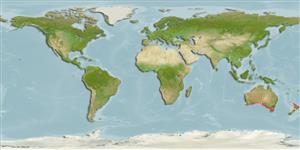Elasmobranchi (squali e razze) (sharks and rays) >
Carcharhiniformes (Ground sharks) >
Scyliorhinidae (Cat sharks) > Scyliorhininae
Etymology: Cephaloscyllium: cephalus, from kephale (Gr.), head, referring to its very broad and depressed head; skylion, Greek for dogfish or small shark. (See ETYFish); laticeps: latus (L.), wide or broad; ceps (New Latin), head, referring to its broad, parabola-shaped head. (See ETYFish).
More on author: Duméril.
Environment: milieu / climate zone / depth range / distribution range
Ecologia
marino demersale; distribuzione batimetrica 1 - 220 m. Temperate; 32°S - 44°S
Eastern Indian Ocean: southern Australia, from Western Australia to New South Wales.
Length at first maturity / Size / Peso / Age
Maturity: Lm ?, range 82 - ? cm
Max length : 150 cm TL maschio/sesso non determinato; (Ref. 6871)
Short description
Chiavi di identificazione | Morfologia | Morfometria
Vertebre: 129 - 138. Head short and very broad. Body robust with inflatable stomach; with dark, mottled and blotched color pattern, and mostly with a dark median stripe on the belly. Labial furrows absent. Denticles large and widely spaced.
Found on the continental shelf from close inshore in shallow to deeper water. Oviparous, hatching at about 14 cm (Ref. 6871). Can expand itself with air or water. Caught by commercial bottom trawlers but of no use to fisheries at present.
Life cycle and mating behavior
Maturities | Riproduzione | Spawnings | Egg(s) | Fecundities | Larve
Oviparous, paired eggs are laid. Embryos feed solely on yolk (Ref. 50449).
Compagno, L.J.V., 1984. FAO Species Catalogue. Vol. 4. Sharks of the world. An annotated and illustrated catalogue of shark species known to date. Part 2 - Carcharhiniformes. FAO Fish. Synop. 125(4/2):251-655. Rome: FAO. (Ref. 244)
IUCN Red List Status (Ref. 130435)
Human uses
Pesca: di nessun interesse
Strumenti
Special reports
Download XML
Fonti Internet
Estimates based on models
Preferred temperature (Ref.
123201): 14 - 18.2, mean 16 °C (based on 175 cells).
Phylogenetic diversity index (Ref.
82804): PD
50 = 0.5000 [Uniqueness, from 0.5 = low to 2.0 = high].
Bayesian length-weight: a=0.00263 (0.00139 - 0.00497), b=3.21 (3.04 - 3.38), in cm total length, based on LWR estimates for this (Sub)family-body shape (Ref.
93245).
Trophic level (Ref.
69278): 4.3 ±0.5 se; based on size and trophs of closest relatives
Resilienza (Ref.
120179): Basso, tempo minimo di raddoppiamento della popolazione 4.5 - 14 anni (Fec assumed to be <100).
Fishing Vulnerability (Ref.
59153): Very high vulnerability (90 of 100).
Nutrients (Ref.
124155): Calcium = 7.44 [1.43, 39.12] mg/100g; Iron = 0.236 [0.062, 0.719] mg/100g; Protein = 18 [15, 21] %; Omega3 = 0.301 [0.127, 0.682] g/100g; Selenium = 13.3 [4.4, 37.3] μg/100g; VitaminA = 12.8 [4.0, 41.2] μg/100g; Zinc = 0.335 [0.164, 0.605] mg/100g (wet weight);
